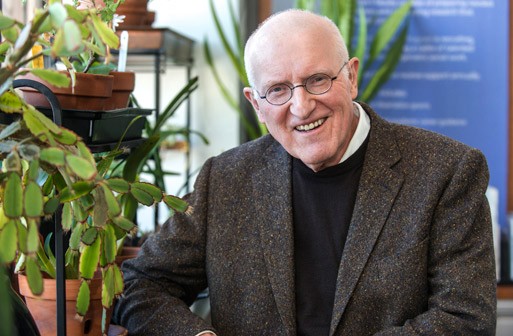“It took a while, but we’ve reached a point where it’s generally accepted that mental health should be given equal weight as physical health in considering one’s well-being,” says James Lubben, director of BC’s Institute on Aging. “Now, we want to put social health on that same level.” (Photo by Lee Pellegrini)
A group of Boston College School of Social Work faculty, program administrators and students are co-leading a national initiative to eradicate social isolation, which they describe as “a silent killer – as dangerous to health as smoking.”
To combat social isolation, the initiative calls for public education, interdisciplinary collaboration between health and human services professionals, and promoting “effective ways to deepen social connections and community for people of all ages.”
The initiative is one of 12 that make up the Grand Challenges for Social Work, a wide-ranging agenda organized by the American Academy of Social Work & Social Welfare (AASWSW) that seeks to enlist social work researchers and practitioners in addressing major societal issues. Other Grand Challenges initiatives include ending homelessness, stopping family violence, harnessing technology for social good and reducing extreme economic inequality.
Louise McMahon Ahearn Professor James Lubben, who is also director of BC’s Institute on Aging, is a co-creator of the social isolation initiative and also has helped AASWSW in putting together the Grand Challenges program. Lubben worked with BCSSW colleagues to draw up a proposal for including social isolation among the Grand Challenges: Assistant Professor Erika Sabbath; doctoral student Jooyoung Kong; Carrie Johnson, assistant director of the Hartford Center of Excellence in Geriatric Social Work (of which Lubben is director) headquartered at BCSSW; and adjunct faculty member Chebali Nadal. Melanie Gironda, associate clinical professor at the University of Southern California, also is co-leading the effort.
Earlier this month, members of the BCSSW contingent traveled to Washington, DC, for the formal unveiling of the Grand Challenges, at the Society for Social Work and Research annual meeting.
“Professional meetings like this are the perfect forum for exchanging ideas and offering or receiving encouragement,” said Lubben last week. “It was a very energizing experience, and hopefully augurs well for the future.”
Although public perception may view it as a problem for the elderly, social isolation affects other populations, according to Lubben and his collaborators, and research suggests that more Americans across a wide age range are feeling socially isolated than in the past.
Physical and mental health problems associated with social isolation – including among children and youths – are well documented, said Lubben, and there also can be public safety ramifications: Many adolescent mass murderers have been described as socially isolated or ostracized from their peers. Organizations such as the US National Institutes of Health, AARP and the World Health Organization have identified social isolation as a major priority.
Lubben said that, over the course of the initiative, he and his collaborators hope to form a more comprehensive picture of social isolation, by examining societal and demographic trends over a period of decades that have made it more difficult to form and maintain relationships.
“It took a while, but we’ve reached a point where it’s generally accepted that mental health should be given equal weight as physical health in considering one’s well-being,” said Lubben. “Now, we want to put social health on that same level.”
To accomplish this, social isolation should be part of social work education curriculums, Lubben and co-authors said, and assessment and intervention for social isolation should be incorporated into the profession’s practice protocols. On a broader level, policies and programs that address social isolation are needed, they added, as are communities that enhance strong social ties.
Interdisciplinary cooperation will play a key role in understanding and eradicating social isolation, Lubben and the co-authors note. Epidemiologists could identify at-risk populations and subpopulations. Health service researchers could focus on controlling for social isolation in their models. Biologists and neuroscientists could examine biological pathways that account for the linkage between isolation and health consequences. Clinical researchers could develop and test interventions.
“Ultimately, we all need to realize the importance of social interactions in our personal lives,” said Lubben. “We should factor our social health into career and other life decisions, and recognize that our social ties are something we need to nurture. Those connections are central to our health and well-being.”
-- Sean Smith, News & Public Affairs





